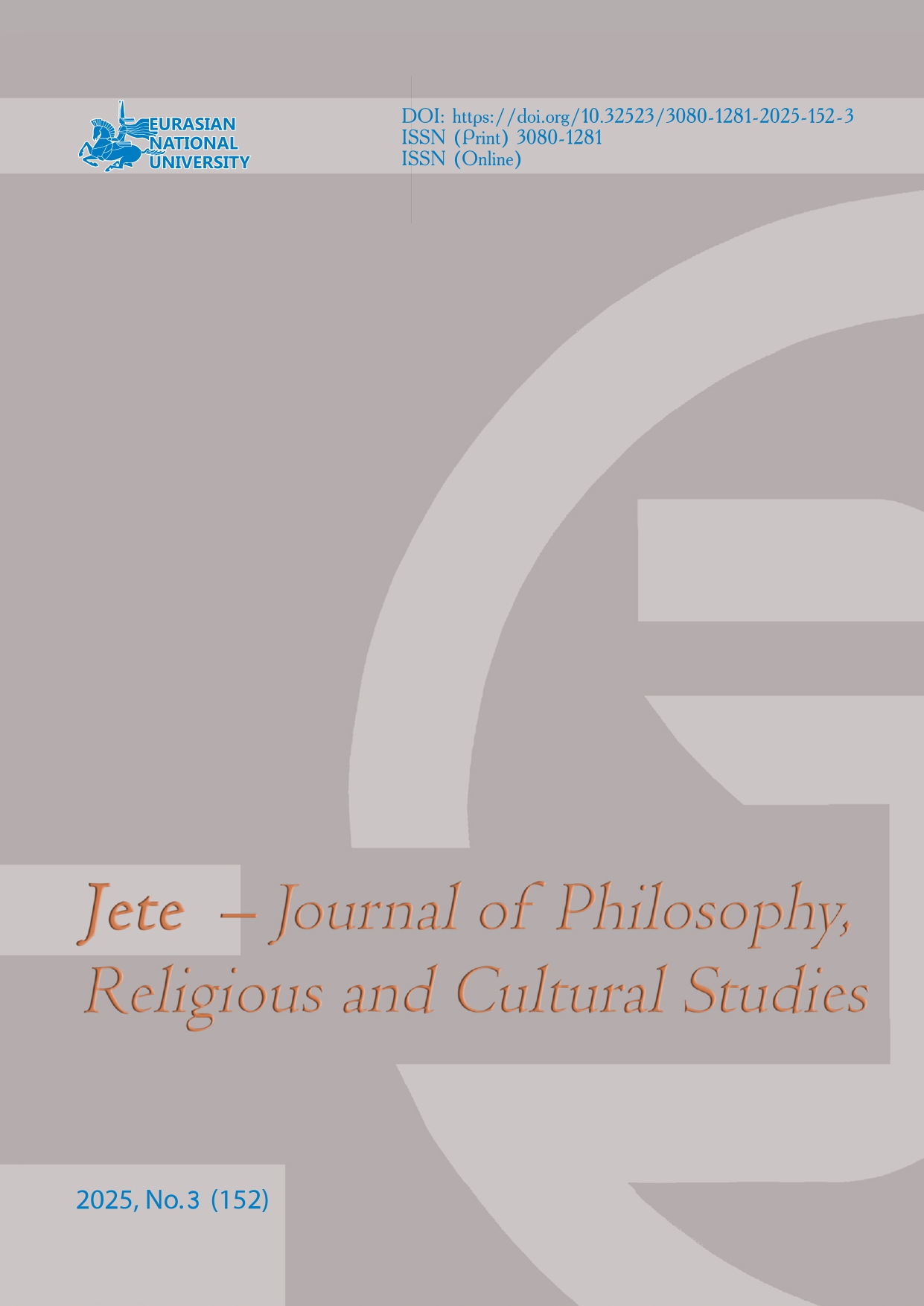"ANILINE" AND "ALIZARINE": SYNTHETIC ORGANIC DYES IN AZERBAIJANI CARPETS OF THE LATE 19th-EARLY 20th CENTURIES
Научная статья
Views: 140 / PDF downloads: 61DOI:
https://doi.org/10.32523/3080-1281-2025-152-3-165-185Keywords:
dyeing, carpets, natural dyes, madder, indigo, synthetic organic dyes, aniline dyes, alizarin dyesAbstract
The paper accentuates the need for more in-depth studies of synthetic organic dyes used to colour Azerbaijani carpets since the end of the 19th century.
In the work, the distinction between aniline and alizarin dyes is made on the ground of reviewing the evolution of early synthetic dyes represented by basic, acid, mordant, and acid-mordant dyes, as well as their technical characteristics.
The paper carries out an analysis of local written sources of the late 19th and early 20th centuries mentioning early synthetic aniline and alizarin dyes used in carpets of Azerbaijan.
The analysis shows that the main transition from the application of natural dyes to aniline ones occurred at the turn of 1880 and was caused by:
- the sharp increase in the local carpet production stimulated by the growing demand from foreign markets;
- the cessation of cultivation of madder in the Caucasus due to the transition of the world textile industry to the use of synthetic alizarin and other artificial dyes.
The widespread of using alizarin dyes in the local carpets began not until the second quarter of the 20th century. It was connected with the beginning of the activities of the “Zakgostorg” Transcaucasian State Export-Import Trade Company and the "Azsanatbirliyi" Azerbaijan Industrial Association
In conclusion, problems associated with conducting researches in this field are noted, as well as prospects for using such researches to know preservation conditions, ways of restoration, and the age of carpets.
Downloads
References
Абдуллаева Н.А. (1971). Ковровое искусство Азербайджана. – Баку: Элм. – 58 с.
Айянгар Н.Р., Тилак Б.Д. (1988). «Основные красители». Химия синтетических красителей, ред. К. Венкатараман. Том IV. – Ленинград. – С.109–162.
«Ализарин». (1988). Химическая энциклопедия. Том 1. – Москва. – С. 82.
«Антраценовые красители». (1926). Большая советская энциклопедия, ред. О.Ю.Шмидт. Издание 1-е. Том III. – Москва. – С. 104.
Венкатараман К. (1956). Химия синтетических красителей. Том I. – Ленинград: Государственное научно-техническое издательство химической литературы. – 805 с.
Венкатараман К. (1957). Химия синтетических красителей. Том II. – Ленинград: Государственное научно-техническое издательство химической литературы. – 842 с.
Воронков Н.В. (1931). Крашение шерстяной ковровой пряжи прочными красками. Производство ковров. Сборник статей по технике ковроткачества, ред. Н.Н. Соболев. – Москва. – С.71–96.
Гемилиан В.А. (1895). Краски органические искусственные. Энциклопедический словарь Брокгауза и Ефрона. Том XVIa. – Санкт–Петербург. – С. 520–535.
Зедгенидзе Я. (1891). Производство ковров и паласов. Сборник материалов для описания местностей и племен Кавказа. Город Шуша. Выпуск XI. – Тифлис. –С. 1–51.
Исаев М.Д. (1932). Ковровое производство Закавказья. – Тифлис: Науч.-исслед. ин-т Кавказоведения Акад. наук СССР. – 224 с.
Керимов Л. (1983). Азербайджанский ковер. Том 2. – Баку: Гянджлик. – 241 с.
Ковровый промысел в Кубинском уезде, Бакинской губернии. (1902). Кустарная промышленность на Кавказе. Выпуск I. – Тифлис: Тип. К. П. Козловского. – 71 с.
Коган И.М. (1956). Химия красителей. Издание 3-е. – Москва: Госхимиздат. – 696 с.
Лидов А.П. (1895). Краски органические естественные. Энциклопедический словарь Брокгауза и Ефрона. Том XVIa. – Санкт–Петербург. – С. 519–520.
Лидов А.П. (1895). Крашение. Энциклопедический словарь Брокгауза и Ефрона. Том XVIa. –Санкт–Петербург. – С. 602-609.
Нарышкин Н.А. (1874). Сведения о мареноводстве в Хасав-Юртовском округе. Газета политическая и литературная «Кавказ» [Тифлис], №40, 10 (22) апреля. – С. 2-3
Отчёт о деятельности Кавказского Кустарного Комитета в 1909 году. (1910). – Тифлис. – 36 с.
Отчёт о деятельности Кавказского Кустарного Комитета в 1910 году. (1911). – Тифлис. – 33 с.
Пиралов А.С. (1913). Краткий очерк кустарных промыслов Кавказа. Издание второе. – Санкт-Петербург: типо-лит. "Якорь". – 128 с.
Хатисов К. (1894). Кустарные промыслы Закавказского края. Отчёты и исследования по кустарной промышленности в России. Том II. – Санкт-Петербург: Типографія В. КиршвДУМА. – С. 259-370.
Чекалин М.А, Пассет Б.В, Иоффе Б.А. (1980). Технология органических красителей и промежуточных продуктов: учебное пособие для техникумов. Издание 2-е. – Ленинград: Химия, Ленинградское отделение. – 471 с.
Barnett, Jennifer C. (2007). “Synthetic Organic Dyes, 1856-1901: an Introductory Literature Review of Their Use and Related Issues in Textile Conservation”. Studies in Conservation. Volume 52, Issue Sup1, 2007, - P. 67-77.
Chrome Colours for Wool. (1910). Cassella Color Company, – New York. – 148 p.
Eiland, Murray Lee III. (1999). “Problems Associated with the Dissemination of Synthetic Dyes in the Oriental Carpet Industry”. Journal of the International Committee for the History of Technology, 5. – P. 138-159.
Fey, Irving W. (1919). The Chemistry of the Colour-Tar Dyes. – New York. – 516 p.
Jacoby, Heinrich. (1964). “Materials Used in the Making of Carpets”. A Survey of Persian Art from Prehistoric Times to the Present. Vol. 6 (Islamic Period: Carpets, Metalwork, Minor Arts, Ornament, Music), edited by Arthur Upham Pope. Under the auspices of the Asia Institute of Pahlavi University. – Tehran, London, New York, & Tokyo. – P. 2456-2465.
Keijzer, Matthijs de,et al. (2012). “Indigo Carmine: Understanding a Problematic Blue Dye”. Studies in Conservation. Volume 57, Issue sup1. – P. 87-95.
Mumford, J.K. (1900). Oriental rugs. – New York. – 442 p.
Sansone, Antonio. (1888). The Dyeing and Bleaching of Wool, Silk, Cotton, Flax, Hemp, China, Grass etc. – Manchester. – 380 p.
Sansone, Antonio. (1887). The Printing of Cotton Fabrics. – Manchester. – 476 p.
Downloads
Published
Issue
Section
License
Copyright (c) 2025 Ялчин Салимов (Автор)

This work is licensed under a Creative Commons Attribution-NonCommercial-NoDerivatives 4.0 International License.













